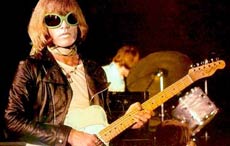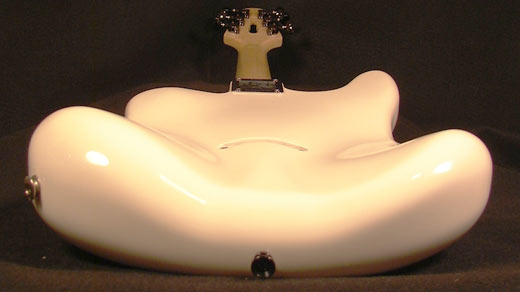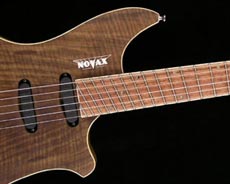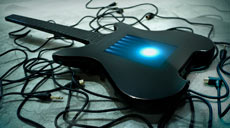The shape of things to come – innovations in guitar technology
If we could see into the future of the guitar, say 50 years, what would people be playing and what would they be playing their guitars through? I’ll bet there will be a good percentage of users playing a 1950s designed guitar though a class A/B valve amp, but that’s not what this article is about; it’s about the future and the possibilities! Remember to bookmark this page and come back in 50 years to see if my predictions come true…
This is already such a big subject so I’m not going to be discussing effects and software here, perhaps guitar effects can be left to another article or two.
Shape, materials and construction

Shapes are in one way limited only by your imagination but to endure and be popular they must have some ergonomics. Both myself and Kerry have looked at quite a few new guitar and headstock shapes and methods/theories of guitar design. Hopefully one day people will break away from the Fender/Gibson 50s design stranglehold.
Body materials are an option for manufacturers to make their guitars different in appearance and tone. Wood? I think most of the woods have been tried, there’s a great reference to wood and tone on the Warmoth website. Perspex – Dan Armstrong first used perspex in the 60s and the material has been used by quite a few budget guitar companies since then; so it must be cheap to produce/machine, but low on the tones that sound connoisseurs appreciate. Aluminium – Travis Bean made guitars with aluminium necks, Tokai famously produced the aluminium bodied Talbo range of guitars, though now they make a wood version of the same design… Carbon fibre guitars are more and more popular, probably the most famous user of this or carbon composite materials is Parker.

Instead of just changing the material of guitar body construction, there is a ‘digital luthier’ KOZM Guitars in Oregon, USA who makes guitars on a 3D priciple rather than out of planks of wood. Made in real 3D shapes some of the guitars are in parts up to 5″ thick but don’t feel heavy, take a look at the process. So wood might feature in the future of guitars, it’s an appealing material. In fact that most modern of modern necessities the mobile phone looks better in wood rather than metal/plastic. Also in looking at alternative shapes and construction I’d recommend you look at Teufel Guitars, very interesting! Also let’s not forget Steinberger who pioneered ‘headless’ guitars starting as far back as 1979, using composite materials and minimal design, perhaps it was too much too soon, or just too cricket bat!

Guitar necks

Let’s move along and look at the guitar neck, it’s very important as it’s where the musicality of an instrumentalist derives from. So any different feel will make a difference to how you play, how well you can play certain styles and even perhaps inspire you to play certain scales and passages differently. Necks on the most popular ranges of guitars differ in scale length and also in fretboard radius. The radius, the roundness of the fretboard profile, can make the guitar more comfortable for chord work (more curved) or lead guitar (more flat). What about the future? We have seen digital guitars by Casio etc who replace the fretboard with buttons, but they never got very popular, I’d guess because of their limiting on/off button nature. A nice innovation I saw recently was by Mikey Guitars which can switch between fretted and fretless; there’s a slider mechanism to raise/lower the frets. I think this is really a niche design, it’s not going to take off! Also IMHO small niche is the fan fret guitar innovation, to provide more precise intonation (and looks cool), I think Novax are the innovators here.
Electronics and amplification
Despite advances in computer modelling techniques people still seem to prefer the sound of old analogue valves, this might be the same in 50 years time perhaps. Instead of just trying to replace and mimic the valve sound I wonder if companies will develop new types of valves again. I’ve heard about the difficulties of sourcing certain valves and the same valve serial numbers crop up again and again in amp specification (EL34 & 12AX7 anyone?). Transistor amps are sometimes looked down upon by the guitar community but I think there has been some fantastic tranny amps made, their strength is in the clean tones. I have fond memories of my old Carlsbro Scorpion 30 watt 2×12 Celestion amp, it was so clean and chiming bell like sounding, the tremolo was great too. It did have a problem with the volume know though which jumped from inaudible to very loud. More and more people will probably use their computer as an audio interface and be playing through speakers connected to the computer. On computers it’s quite run-of-the-mill now to have 5.1 or 7.1 sound capabilities, great for certain games, movies and DVDs but what about that mono phono cable connector to your guitar… Seems a bit under-specced now in comparison! PCs have gone from ‘beep’ to super-3D -spacial-digital- optical-dolby- HD-16.1-sub sound in 15 years or so!

This leads us to the other side of the electronics equation; pickup technology. It’s quite rare to find stereo guitars, anyway, stereo is not that natural for a guitar IMHO, it’s one sound source. There are many effect pedals that create a stereo image from the mono guitar; like 2 varying channels of the effect/dry signal. Currently a more logical stereo type division would be if each guitar pickup had it’s own audio channel, so for 2 pickup equipped guitars both pickups would be active at the same time and the sound come from different speakers. Lots of guitars have 3 pickups so having 3 speakers and/or a way of selecting all 3 pickups at once would be good. Let’s extend the reasoning, instead of a channel of audio for every pickup let’s switch to thinking about a channel of audio for every string. This is my preferred way forward, the speakers can even be customised for the pitches they will be serving up. So a high fidelity 6 string guitar amp would have 6 channels/speakers. I hope to see a 6 channel guitar & amplifier in the near future! I see there is a company ZexCoil that make a one-coil-per-string pickup now, but I don’t think this is the same as what I’m talking about. Also it’s possible to fit a stereo pickup system to your guitar now using the 3DXY pickup from Pauls 3D systems.
[amazon_carousel widget_type=”SearchAndAdd” width=”610″ height=”200″ title=”Noiseless pickups from Amazon” market_place=”” shuffle_products=”True” show_border=”False” keywords=”noiseless pickups” browse_node=”” search_index=”MusicalInstruments” /]
Of course pickups don’t have to be magnetic devices or work in the standard way of the ubiquitous single coil and humbucker pickups everyone seems to use. Why not sense the string vibration in another way? Well there are other ways right now, some guitars and many acoustics use the piezo electric pickup or electret /condenser microphone technology to get sound to amplifiers. Also if you have a MIDI pickup in your guitar, that will be using piezo technology to transmit the data to the synthesiser. Lastly, as far as I know, we have optical pickup technology. An optical sensor ‘sees’ the string movement and sends that data as sound waves to your amplifier. The advantage of this system is that seeing the string vibrate cannot dampen it whereas a magnetic field can dampen of affect the string vibration. It’s said to be a very clean system with no electromagnetic interference being read and put into the signal – so no hum or buzzing because of other things like AC power or lighting nearby. The most prominent optical pickups for guitars are by Lightwave Systems, if you want to read more.
Other stuff
Looking further afield I was interested to see the Misa Kitara; an instrument which uses buttons on a fretboard for the fingering and a multi-touch LCD pad as the playing area where pickups would traditionally be. This instrument has no strings, it looks and sounds a bit ‘science-fiction’ but I don’t know if it is actually a guitar any more than a guitar hero game controller is. So I don’t think the Misa instruments are part of the guitar’s future.

I’ve not mentioned the robot tuning systems like on the Gibson Robot guitar, among others, because I don’t really think it’s much of an innovation, any more than a pick holder that you glue to your headstock is. I’d call robot tuning a luxury convenience like having a maid who tunes your guitar for you. I like the Fernandes Sustainer system, but I think that will be classified as a guitar effect, so will be in a later article here on GDR.
Thanks for reading, if you enjoyed this please give us a Facebook thumbs up or Google +1 to spread the article about. Also on our Facebook page we often post snippets about new guitar stuff that doesn’t warrant a full article so it’s worth connecting with GuitarDR on there!
Please let me know, below, if you think I’ve missed any great innovations that might feature in the future of the guitar. Mark.
15 thoughts on “The shape of things to come – innovations in guitar technology”
Leave a Reply
You must be logged in to post a comment.

Evertune system…hella cool.
http://www.youtube.com/user/EverTune8#p/u/11/PbWJagI0nM8
http://evertune.com/news.html#a3
Evertune is in the same underwhelming category as the Gibson robot tuning for me. It’s just a housekeeping thing, just like the system that monitors and adjusts the tyre pressure of your car is great for some people but ‘meh’ for others if they would have to pay any extra for it. We are talking about 50 years tech and artistic advance here. Thanks for your comment though!
The kitara and a couple other companies producing similar holds some promise for those of us who would rather not have to use a keyboard as a MIDI controller. The slanted frets was tried years ago — by Rickenbacker first I think — and was a massive failure then, too. Using other materials is promising in the search for alternate tones, but it it’s nothing new in any way. Regarding pickups the old way seems to produce the best from metal strings. Fender’s samarium cobalt pickups are a perfect example of vanilla, Milquetoast sound, EMGs have plenty of good and bad as do all active setups. Regardless, I’ll stick with the ’50s inventions for my pickups. In all, most of this innovation is useless garbage from people who ought to spend more time playing than tinkering.
Thanks for the comment. I think we need both the players and the tinkerers. Then we need people who are a bit of both – to apply the innovations creatively! I agree that many players fuss too much over tone and effects; such as worring about the metal their strap buttons are made of in case it dampens their sustain!
My favourite idea above, is having 6 channels/amps for the 6 strings in the guitar and the textural possibilities of that. As far as I know that is my idea, but I’m no electronics genius, so I can’t make it happen. But like I said PCs commonly have 7.1 channel sound now, the sound cards cost very little. Who knows what the future holds – I’ll update this article periodically and often put new finds on the Facebook page we have. Keep on Rockin’, Mark.
“Hopefully one day people will break away from the Fender/Gibson 50s design stranglehold”.
Hopefully not I think. Why the word hopefully? are you ‘tired’ of that design? I look at my strat everyday with the same love I have for the last 17 years since I got the first one. Watch Contours and body horns. Every on from Clapton to Richards say this is the ultimate guitar, Leo got it right in the first place. Or course there’s room for innovation and experimentation, but when it comes to the real thing, that’s why old timers like Buddy Guy or young guns like Mayer come back to the Strat.
Peace
Hi Gerry, looking 50 years into the future I do wish that something new happens and there are new major players in the guitar manufacturing business who got there by a great leap forward – some kind of ground breaking technology or designs. Then guitar shop walls won’t be full of Strat and Les Paul clones (the design stranglehold) and people will have more choice. However Fender and Gibson will still make their lovely re-issues hopefully. In the car industry there was also a ‘perfect design’ – the VW Beetle, still selling pretty well. That industry has much more money to pay the stylists and innovators to modernise I think, it’s part of their business model; the refresh, the new design, adding new tech.
Hi Mark:
Great article but you have left out one of the real pioneers and leaders in eco-friendly electric guitars that do not sacrifice anything in tone and performance – Flaxwood Guitars. They are made entirely of an NFC (natural fiber composite), using harvested and controlled renewable spruce in Finland. Bottom line for these guitars: no exotic hardwoods, very little fossil fule consumption in the manufacturing process and no waste – the entire tree is used and it’s vintage tone right out of the case.
New materials are always interesting, and that’s a good motive, to be eco-friendly, I’ll look at your link with interest. Cheers Ed.
check out the advert for the Touch Wood phone, it’s great! http://www.youtube.com/watch?v=C_CDLBTJD4M&feature=player_embedded
Hello everbody.
What about the unique guitars of Ulrich Teuffel. His work is more than one step ahead. Great design, cool contours and every guitar is so outside the box…
He told on the DVD “Guitar Gourmets”, that his approach was to rethink what Leo Fender started…
Check this out: http://www.teuffel.com
Hi Uwe, I mentioned and linked to Teuffel’s work in the paragraph below the picture of the Perspex guitar! Great minds think alike 🙂 Mark
What about the guitars made by Moog? I’d certainly call that a “leap-forward” in thinking about the electrical side.
http://www.moogmusic.com/products/Moog-Guitars
It’s a pretty interesting guitar for now, but as with all Moog stuff I’ve seen it’s too expensive for mass market (cheapest E1 model with trem = £3,000 approx). Everyone in the video kept talking about the sustainer function, which I think will become more and more popular, I’ve hankered after an e-bow in the 90s and the Fernandes Sustainer in the last 5 years but never got round to spending money on them. Just think if 99% of the electric keyboards/synths didn’t have any sounds that sustained for as long as you held down the key! The body design is very influenced by the Fender/Ibanez, which is disappointing to me. Thanks for your comment.
Very insightful blog. Carbon Concepts is pioneering the field of composite guitars:
http://carbonconcepts.net/carbon-fiber-blog.html
From Fender to Teuffel – all great stuff, but mostly just further refinements of same old stuff.
When do you figure someone is going to start producing some interesting, original Music again?